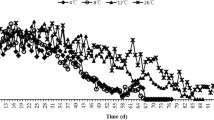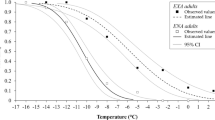Abstract
The spread of invasive species is an increasing problem world wide. The invasive slug Arion lusitanicus has spread to most parts of Europe, where it often is considered as a serious pest. There is a need for better knowledge of its ecophysiology to be able to predict the effect of climatic factors, such as temperature and humidity on the population dynamics and abundance. The aim of the present study was to assemble data on the water balance and drought tolerance of eggs and juveniles of A. lusitanicus. Both eggs and juveniles had little capacity to prevent evaporative water loss and lost water when the ambient humidity fell below 99.8 and 99.5%, respectively. The water conductance of the cuticle of juveniles was 242 μg cm−2 h−1 mmHg−1 and resembles that of other slug species. Both eggs and juveniles of A. lusitanicus tolerate a substantial water loss. There was no difference in water loss resistance between eggs and juveniles, but the eggs were slightly more tolerant to water loss than the juveniles. The percent water loss causing 50% mortality was 72% for the juveniles and 81% for the eggs. Despite A. lusitanicus’ tolerance of substantial water loss, its survival depends on humid habitats.




Similar content being viewed by others
References
Bayley M, Holmstrup M (1999) Water vapor absorption in arthropods by accumulation of myoinositol and glucose. Science 285:1909–1911
Bayne CJ (1966) Observations on composition of layers of egg of Agriolimax reticulatus grey field slug (Pulmonata stylomatophora). Comp Biochem Physiol 19:317–337
Bayne CJ (1968) A study of desiccation of egg capsules of 8 gastropod species. J Zool 155:401–411
Bayne CJ (1969) Survival of the embryos of the grey field slug Agriolimax reticulatus, following desiccation of the egg. Malacol 9:391–401
Binney WG (1878) The terrestrial air-breathing mollusks, 1st edn. Bull Mus Comp Zool Harv Coll, Cambridge
Carmichael EB, Rivers TD (1932) The effects of dehydration upon the hatchabilty of Limax flavus eggs. Ecol 13:375–380
Carne-Cavagnaro VL, Keller MA, Baker GH (2006) Soil moisture and soil type influence the breeding behavior of the pest snail Cernuella virgata (da Costa). Appl Soil Ecol 33:235–242
Carrick R (1942) The grey field slug Agriolimax agrestis L, and its environment. Ann Appl Biol 29:43–55
Dainton BH (1954) The activity of slugs. 1. Induction of activity by changing temperatures. J Exp Biol 31:165–187
Damgaard C, Hojer R, Bayley M, Scott-Fordsmand JJ, Holmstrup M (2002) Dose-response curve modeling of excess mortality caused by two forms of stress. Environ Ecol Stat 9:195–200
Edney EB (1977) Water balance in land Arthropods, 1st edn. Springer, Berlin
Getz LL (1959) Notes on the ecology of slugs: Arion circumscriptus, Deroceras reticulatum, and D. laeve. Am Midl Nat 61:485–498
Grimm B, Paill W (2001) Spatial distribution and home-range of the pest slug Arion lusitanicus (Mollusca: Pulmonata). Acta Oecol Int J Ecol 22:219–227
Grimm B, Paill W, Kaiser H (2000) Daily activity of the pest slug Arion lusitanicus Mabille. J Molluscan Stud 66:125–128
Holmstrup M (2001) Sensitivity of life history parameters in the earthworm Aporrectodea caliginosa to small changes in soil water potential. Soil Biol Biochem 33:1217–1223
Holmstrup M (2002) Strategies for cold and drought tolerance in permeable soil invertebrates. Doctor’s dissertation (DSc). National Environmental Research Institute, Silkeborg, Denmark
Holmstrup M, Westh P (1995) Effects of dehydration on water relations and survival of lumbricid earthworm egg capsules. J Comp Physiol B 165:377–383
Hulme PE (2009) Trade, transport and trouble: managing invasive species pathways in an era of globalization. J Appl Ecol 46:10–18
Kozlowski J (2000) Reproduction of Arion Lusitanicus Mabille, 1868 (Gastropoda: Pulmonata: Arionidae) introduced in Poland. Folia Malacol 8:87–94
Kozlowski J (2001) Daily activity of Arion lusitanicus Mabille, 1868 (Gastropoda: Pulmonata: Arionidae). J Plant Prot Res 41:279–286
Kozlowski J (2007) The Distribution, biology, population dynamics and harmfulness of Arion lusitanicus Mabille, 1868 (Gastropoda: Pulmonata: Arionidae) in Poland. J Plant Prot Res 47:219–230
Lee JE, Janion C, Marais E, van Vuuren BJ, Chown SL (2009) Physiological tolerances account for range limits and abundance structure in an invasive slug. Proc Royal Soc B Biol Sci 276:1459–1468
Machin J (1964) Cutaneous regulation of evaporative water loss in the common garden snail Helix aspersa. Nat Wiss 53:18
Machin J (1966) Evaporation of water from Helix aspersa.4. Loss from mantle of inactive snail. J Exp Biol 45:269–278
Machin J (1975) Osmotic gradient across snail epidermis evidence for a water barrier. Science 183:759–760
Maraldo K, Holmstrup M (2009) Recovery of enchytraeid populations after severe drought events. Appl Soil Ecol 42:227–235
McCraw (1961) Life history and growth of the snail, Lymnaea humilis Say. Trans Am Microsc Soc 80:16–27
Meeh K (1897) Oberflachenmessungen des menschlichen korpers. Z Biol 15:425–458
Meyerson LA, Mooney HA (2007) Invasive alien species in an era of globalization. Front Ecol Environ 5:199–208
Price CH (1980) Water relations and physiological ecology of the salt marsh snail, Melampus bidentatus Say. J Exp Mar Biol Ecol 45:51–67
Prior DJ (1984) Analysis of contact-rehydration in terrestrial gastropods—osmotic control of drinking behavior. J Exp Biol 111:63–73
Prior DJ (1985) Water-regulatory behavior in terrestrial gastropods. Biol Rev Camb Philos Soc 60:403–424
Prior DJ, Hume M, Varga D, Hess SD (1983) Physiological and behavioral aspects of water balance and respiratory function in the terrestrial slug, Limax maximus. J Exp Biol 104:111–127
Quinteiro J, Rodriguez-Castro J, Castillejo J, Iglesias-Pineiro J, Rey-Mendez M (2005) Phylogeny of slug species of the genus Arion: evidence of Iberian endemics and of the existence of relict species in Pyrenean refuges. J Zool Syst Evol Res 43:139–148
Slotsbo S, Hansen LM, Holmstrup M (2011) Low temperature survival in different life stages of the Iberian slug, Arion lusitanicus. Cryobiol 62:68–73
South A (1992) Terrestrial slugs. Biology, ecology and control, 1st edn. Chapman & Hall, London
Sternberg M (2000) Terrestrial gastropods and experimental climate change: a field study in a calcareous grassland. Ecol Res 15:73–81
Thompson JM, Appel AG, Sibley JL, Keever GJ, Foshee WG (2006) Comparative water relations of three sympatric terrestrial slugs: (Stylommatophora: Agriolimacidae, Limacidae, and Philomycidae). J Ala Acad Sci 77:181–192
Von Brand T, McMahon P, Nolan MO (1957) Observations on starvation and desiccation of snail Australorbis glabratus. Biol Bull 113:89–102
Willis JC, Bohan DA, Powers SJ, Choi YH, Park J, Gussin E (2008) The importance of temperature and moisture to the egg-laying behaviour of a pest slug, Deroceras reticulatum. Ann Appl Biol 153:105–115
Author information
Authors and Affiliations
Corresponding author
Additional information
Communicated by I.D. Hume.
Rights and permissions
About this article
Cite this article
Slotsbo, S., Fisker, K.V., Hansen, L.M. et al. Drought tolerance in eggs and juveniles of the Iberian slug, Arion lusitanicus . J Comp Physiol B 181, 1001–1009 (2011). https://doi.org/10.1007/s00360-011-0594-y
Received:
Revised:
Accepted:
Published:
Issue Date:
DOI: https://doi.org/10.1007/s00360-011-0594-y




